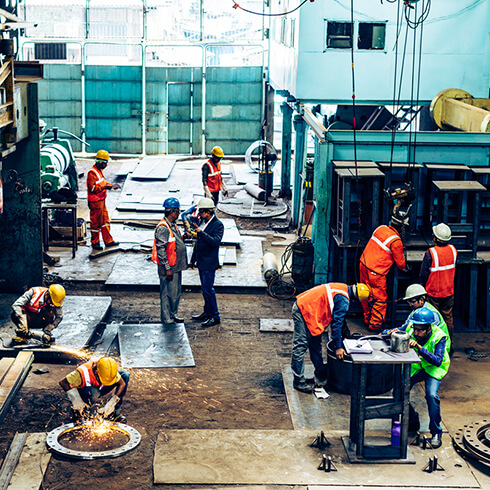Leadership transitions are inevitable. Yet, in many manufacturing operations, each new executive arrival triggers a wave of disruption—strategic resets, halted initiatives, and rebranded programs.
Much of the operational progress quietly erodes in the background, and frontline teams are left thinking, “Here we go again.” The root issue isn’t leadership turnover. It’s the fragility of how Lean has been implemented. In operations, this cycle of reinvention creates what we call “initiative fatigue”—an exhaustion from constantly shifting priorities, metrics, and improvement slogans. To break that cycle, manufacturers need more than a good Lean program. They need a Lean Operating Structure and a robust lean management system designed to withstand leadership changes, unify teams, and anchor improvement into the fabric of daily operations.
A Structure That Outlasts the People Who Run It
Think of your Lean Operating Structure like the power grid of your factory. Leaders may come and go, but the power must stay on. Sustainability starts by shifting Lean from a leadership initiative to an operational infrastructure. This means moving beyond tools and kaizen events toward a management structure that governs how decisions are made, how performance is reviewed, and how accountability is created and sustained at every level.
This is where Operational Performance Management (OPM) becomes critical. It isn’t just a set of routines. It’s the backbone of Lean governance. It clarifies what good looks like, defines the rhythm of performance, and ensures that improvements do stall when leadership rotates.
From Rituals to Results: Rethinking Daily Management
At many sites, daily huddles and weekly reviews happen like clockwork. But structure without intent is theatre. To build resilience, meetings must evolve from habitual rituals into platforms for decision-making.
Start with clear terms of reference for every recurring meeting. Define who participates, what gets reviewed, and how decisions are made. Use a consistent cadence—daily for local issues, weekly for cross-functional alignment, and monthly for strategic integration.
But here’s the crucial part: define and document the rules for how participants engage. Are the right metrics being challenged? Are actions being closed before the next review? Are the same problems surfacing without resolution? The outcome of every recurring meeting should be: ACTIONS, ACTIONS, ACTIONS.
A Lean Operating Structure is only as strong as the discipline with which it is applied. A healthy structure is recognizable by how rapidly actions are resolved. Such a structure creates what we call “muscle memory” in the organization. Over time, teams stop waiting for direction. They know how to respond when performance slides and how to escalate when it can’t be solved locally. The structure is kept alive by the combined energy of the participants.
If you have to pour energy into every meeting it is not sustainable. It is the difference between people coming to you with problems or people coming to you with their resolutions. This kind of autonomy is also a key goal of business improvement consultants, who aim to embed improvement capabilities within client teams.
Flatline Performance: The Silent Alarm
There’s a subtle danger in metrics that don’t move. In a stable operation, flatlining KPIs are often seen as a win. But if your improvement engine is working, why isn’t performance improving?
A mid-sized food manufacturer recently faced this very scenario. Output was steady. Downtime hovered at acceptable levels. But profitability was slipping. A deeper investigation using a true root cause approach revealed that corrective actions weren’t being executed. Problems were logged but left unresolved. The operating rhythm existed, but the system was inert. This type of scenario often leads organizations to seek operational due diligence—a deeper assessment into the real performance mechanics, not just surface metrics.
The turning point wasn’t a major initiative. It was a reset of ownership. Meeting participants were re-briefed, action tracking was enforced, and outcomes were reviewed with rigor. Within six weeks, OEE began to rise, and margin recovery followed. This isn’t about dramatic overhauls. It’s about operational fidelity.
Leadership Transitions Should Elevate, Not Reset
When a new leader joins, the instinct is to make their mark. But if the Lean Operating Structure is functional, their role isn’t to start over—it’s to enhance. The best leaders don’t rewrite the playbook. They ask sharper questions, raise expectations, and model behaviors that reinforce the system. This is exactly the kind of resilient governance supported by leading supply chain consulting companies.
They use the existing OPM framework to probe where accountability might be thin, where cross-functional coordination and collaboration are missing, and where improvements are stuck.
A well-functioning Lean system frees new leaders to focus on growth, innovation, and market strategy—because the day-to-day discipline is already in place.
Build for Resilience, Not Just Compliance
It’s easy to mistake compliance with sustainability. A factory might tick all the boxes—visual boards, daily meetings, red-green KPIs—but still struggle with stagnation. Resilient systems don’t just follow procedure. They evolve.
To build that kind of resilience:
- Create clarity and overview: Standard procedures for performance reviews from Tier 1 short operational reviews to Tier 3 strategy reviews.
- Teach problem solving and root cause thinking, not just problem reporting.
- Close the feedback loop. Install follow-through, not just participation.
- Connect performance reviews with real-time decisions.
And perhaps most critically: invest in coaching people. Different people have different coaching needs, one size never fits all. If the structure is robust, the people will adjust. The system shouldn’t have to.
How to Stress-Test Your Lean Operating System
Even the most disciplined Lean Structures can appear healthy on the surface—until something disrupts the status quo. The real test of sustainability is in moments of pressure, ambiguity, or leadership change.
Here’s how to assess whether your Lean Operating System can truly stand on its own:
- Pull a month of Tiered Meeting data. Don’t just look at whether the meetings happened—dig into what they produced. Are the same issues being discussed week after week without resolution? Are actions being logged but never closed? A sustainable structure builds momentum by solving problems, not recycling them.
- Ask a line supervisor how they respond to a missed KPI. A resilient system enables action without top-down intervention. Does the supervisor have a clear escalation process? Do they know when to escalate and to whom? If they hesitate or default to “waiting for the plant manager,” the system is still reliant on individuals, not process.
- Simulate a leadership change. What would actually happen if your site leader exited tomorrow? Would the daily meetings still run? Would Tier 2 and Tier 3 reviews stay on schedule? Would the team still close actions and follow through on priorities—or would everything pause until someone new steps in?
- Interview a new team member. New hires are often the most honest reflection of your operating rhythm. Within 30 days, can they explain how performance is managed in their area? Do they understand how improvement ideas are captured and acted on? A strong system introduces clarity from day one; a fragile one leaves people guessing.
This stress test is about identifying if and where your structure still relies too heavily on personality or heroics. If performance continuity depends on a few key players, it’s not yet built to scale—or to survive change.
The goal is to make operational excellence the natural rhythm of the business, not something that needs to be reinvented with each new leader or crisis. If your structure system can pass this test, it’s not only scalable: it will sustain.
Progress That Doesn’t Reset
The goal is to create a Lean program that suits your organisation. To build a Lean Operating Structure that sustains, adapts, and grows under any leader. When Lean becomes part of how your business runs—not something it does—you escape the reset cycle. Instead of launching new initiatives every 18 months, you drive sustained performance every day. Leadership changes should mark the next chapter, not the first page. And if your system is built right, the story will keep moving forward. Want to see if your system is ready for that level of resilience?
Explore how a robust lean management system can anchor your progress and protect it from disruption.





